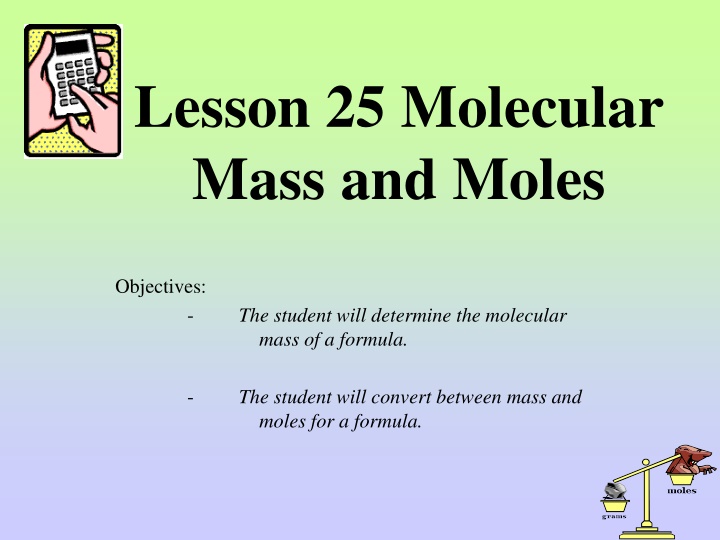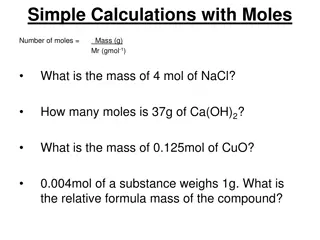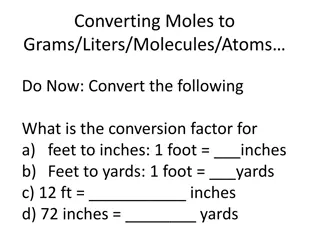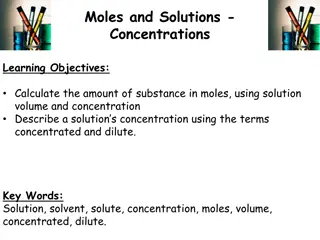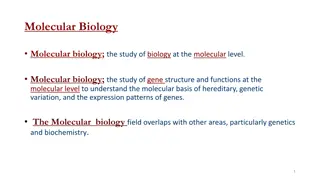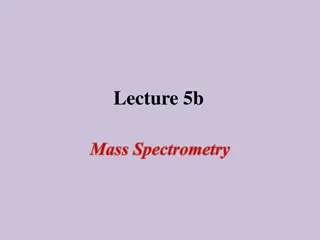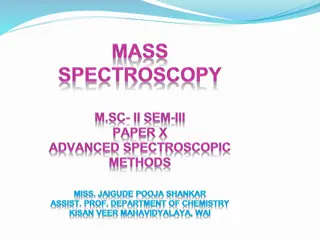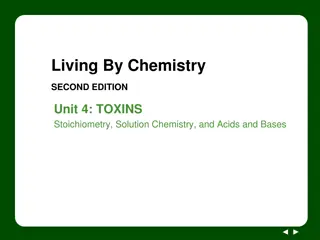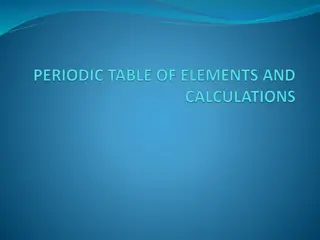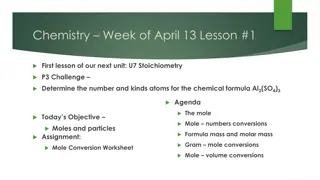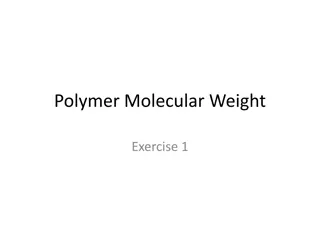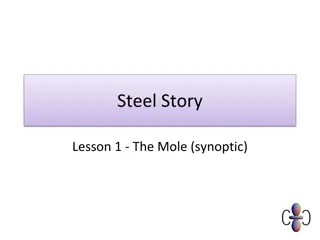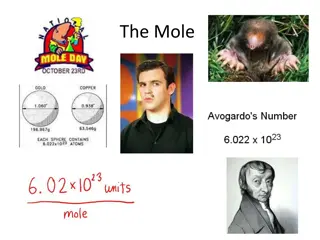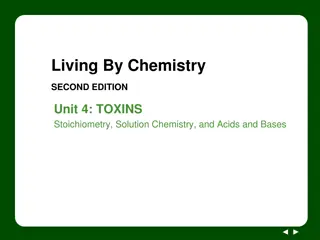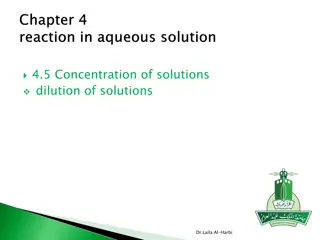Lesson 25 Molecular Mass and Moles
Explore the concept of molecular mass and moles with detailed explanations, examples, and conversion methods. Understand how to calculate the molecular mass of a formula and convert between mass and moles efficiently. Learn about Avogadro's principle and practice converting moles to particles. Enhance your understanding of chemistry fundamentals with this comprehensive lesson.
Download Presentation

Please find below an Image/Link to download the presentation.
The content on the website is provided AS IS for your information and personal use only. It may not be sold, licensed, or shared on other websites without obtaining consent from the author.If you encounter any issues during the download, it is possible that the publisher has removed the file from their server.
You are allowed to download the files provided on this website for personal or commercial use, subject to the condition that they are used lawfully. All files are the property of their respective owners.
The content on the website is provided AS IS for your information and personal use only. It may not be sold, licensed, or shared on other websites without obtaining consent from the author.
E N D
Presentation Transcript
Lesson 25 Molecular Mass and Moles Objectives: - The student will determine the molecular mass of a formula. - The student will convert between mass and moles for a formula.
Moles, Molecular formulas with calculations, and %composition.mpg
I. Molecular Mass The molecular mass of a formula is the mass of that formula expressed in grams per mole. A. This is calculated by adding up the masses of all of the elements contained in the formula for a compound. B. C. Example: H2O contains 2 hydrogen atoms and 1 oxygen atom. When we look on the periodic table, i. Oxygen = 16.00 g/mol ii. Hydrogen = 1.01 g/mol D. Therefore, 2 x 1.01 + 1 x 16.00 = 18.02 g/mol for water, or H2O.
E. Examples: F. If a formula contains parenthesis with subscripts following, the subscript should be multiplied through the parenthesis to calculate the number of atoms of each element 44.01 g/mol 34.02 g/mol CO2 H2O2 G. Examples: Mg3(PO4)2 262.87 g/mol
II. Conversion between mass and moles A. The conversion between mass and moles of a substance is accomplished using dimensional analysis. B. Use the molecular mass of the compound as the conversion factor example: 18.02 g H2O / 1 mol H2O. Flip it upside down if needed to cancel units. i. If given grams: multiply by 1 mole/molecular mass to convert to moles. ii. If given moles: multiply by molecular mass/ 1 mole to convert to grams.
10g of H2O 0.6 n H2O 84 mol of O2 2700 g O2
III. Conversion between moles and particles A. The conversion between moles and number of particles (atoms, molecules, or formula units) is also accomplished with dimensional analysis. B. Avagadro s Principle states that there are 6.02 x 1023 particles in one mole. This then becomes a conversion factor with Avagadro s number and 1 mole as the two terms. C. The direction in which you are converting determines which goes on top.
D. Examples: 1. How many molecules are in 10.0 mol H20 6.02 x 1024 molecules 2. How many moles is 1.23 x 1062 atoms of Rd 2.04 x 1038 moles
IV. Conversion between mass and number of particles A. There is no direct conversion between mass and number of particles. B. This must be done through a two step process. C. First convert mass to moles as described in II above. D. Then convert moles to particles as described in III above.
e. Examples: 1. # of particles in 54.321 g of Gold 1.6602 x 1023 Au atoms 2. # of particles in 54.321 g of CO2 7.430 x 1023 CO2 molecules 3. Mass of 3.6648 x 1023 molecules of H2O 10.97 g H2O
Formula Mass Problems 1. Find the molecular mass of each of the following compounds. Level 1 a. KCl b. NaF c. HI d. LiBr e. RbBr f. BaCl2 g. CaI2 h. Na2S i. MgS j. AlP
2. Find the mass of each of the following, expressed in grams. a. 1.00 mol of CaO b. 1.00 mol of BeSe c. 1.00 mol of KF d. 1.00 mol of SrO e. 2.00 mol of MgI2 f. 2.00 mol of Li3P g. 5.00 mol of CaCl2 h. 0.50 mol of FeBr2 i. 0.20 mol of Cu2O j. 0.40 mol of Hg2Cl2
3. Find the amount of moles in each of the following masses. a. 18.02 g of H2O b. 80.92 g of HBr c. 17.04 g of NH3 d. 190.42 g of MgCl2 e. 36.75 g of K2S f. 25.38 g of SnI2 g. 11.98g of FeO h. 15.0 g of KBr i. 25.0 g of SrS j. 50.0 g of AlF3
Level 2 1. Find the molecular mass of each of the following compounds. a. HNO3 b. Fe2O3 c. H3PO4 d. K2SO4 e. Be5As2 f. NH4NO3 g. RbSO3 h. Li2CO3 i. Mg(OH)2 j. Al2(SO4)3
2. Find the mass of each of the following, expressed in grams. a. 1.00 mol of HC2H3O2 b. 2.50 mol of K2CrO4 c. 0.50 mol of Ca(ClO3)2 d. 0.25 mol of Ba(NO3)2 e. 0.375 mol of Na2Cr2O7 f. 0.25 mol of NaC2H3O2 g. 0.152 mol of H3PO4 h. 0.0582 mol of Li2SO4 i. 0.418 mol of Fe(NO3)3 j. 1.872 mol of Cu(C2H3O2)2
3. Find the amount of moles in each of the following masses. a. 100.00 g of CaCO3 b. 100.00 g of Ni(NO3)2 c. 50.00 g of C6H12O6 d. 25.00 g of K3PO4 e. 15.57 g of Bi(OH)3 f. 3.50 g of AsCl3 g. 0.572 g of Ca3P2 h. 1.750 g of Ca(C2H3O2)2 i. 4.904 g of Al(NO3)3 j. 27.85 g of Fe3(PO4)2
4. Find the amount of formula units (particles) of each of the masses listed in question #3. a. 100.00 g of CaCO3 b. 100.00 g of Ni(NO3)2 c. 50.00 g of C6H12O6 d. 25.00 g of K3PO4 e. 15.57 g of Bi(OH)3 f. 3.50 g of AsCl3 g. 0.572 g of Ca3P2 h. 1.750 g of Ca(C2H3O2)2 i. 4.904 g of Al(NO3)3 j. 27.85 g of Fe3(PO4)2
